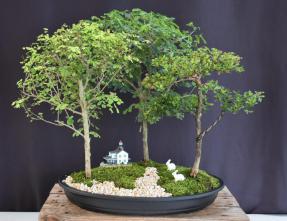Flowering Three Tree Bonsai Forest Group
Black Olive (bucida spinosa
Native to the Caribbean and parts of Florida. Not the edible Olive that we know and love, but does produce a small, black seed-capsule. An evergreen tree with a smooth trunk and has a very dense, full canopy. The lush, dark bluish/green, leathery leaves can be over 2" long and are clustered at branch tips, sometimes mixed with 1" long spines found along the branches. Naturally grows erratically in all directions forming a diamond-like lace.
Brazilian Raintree (pithecellobium tortum)
This hardwood tree is native to Brazil and its rainforests. The raintree has delicate branches and tiny light-green compound leaves and is spiny. The leaves fold up at night or in subdued light. This tree wakes up when we do. Flowers appear as fragrant white puffy blossoms
Campeche (haematoxylum campechianum)
The botanical name Haematoxylum means bloodwood, referring to the dark red heartwood. The trees common name Campeche got its name from the coastal city of Campeche on the Yucatan Peninsula, an important source of the valuable heartwood. The Campeche also grows abundantly in areas of Puerto Rico and is a fast growing ornamental tree. The foliage consist of several pairs of reverse heart-shaped leaflets. The leaves can vary color and in size from 0.4 inches to 4 inches. Yellow, fragrant flowers appear throughout the year. The trunk and branches are thorned and the wood is heavy, hard, and dense. In Mexico, the wood is used for herbal medicines as a natural remedy to treat anemia, tuberculosis, and intestinal parasites.
- Each tree between 14-16 years old, 19" x 23" x 21" tall
- Recommended indoor flowering bonsai tree, grown and trained by Bonsai Boy.
- Potted in a 17" black oval mica container. Suitable humidity/drip tray is recommended. To purchase add $21.95.
- Ceramic house & rabbit figurines included.









